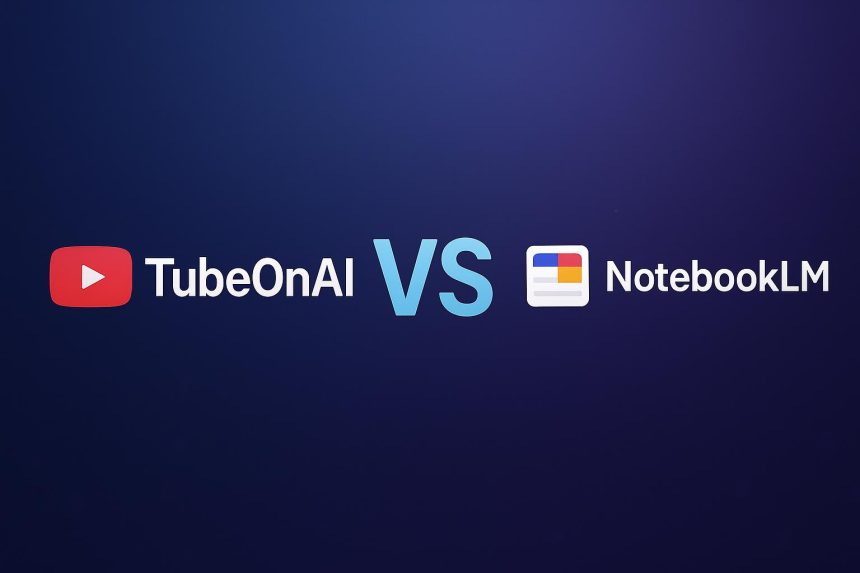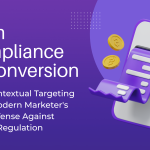TubeOnAI and Google NotebookLM are both AI-powered research assistants, but they serve distinctly different research methodologies and content consumption needs. TubeOnAI can summarize a wide range of content, including YouTube videos, podcasts, blog posts, PDFs, slides, and any publicly accessible online content, while NotebookLM functions as an AI research and thinking partner that lets you “ground” the language model in documents you select.
The fundamental difference lies in their specialization: TubeOnAI excels as a video-first AI research platform optimized for multimedia content analysis, while NotebookLM operates as a document-centric research assistant focused on text-based materials and note organization.
How TubeOnAI Outperforms NotebookLM in Video-Based Research?
TubeOnAI generally outperforms NotebookLM in video-based research because it is specifically designed to analyze video content, offering direct transcription, summarization, and search functions across video platforms. NotebookLM, while excellent for document analysis, lacks this native integration and specialized tooling for efficiently processing and querying video files as a primary source.
TubeOnAI’s Video Specialization: TubeOnAI’s core strength lies in its advanced video content processing capabilities. The platform’s advanced AI algorithms are capable of processing audio and video content directly to extract information and generate accurate summaries even if your source doesn’t contain any transcript. This specialization makes TubeOnAI the ideal choice for researchers, students, and professionals who rely heavily on video-based learning materials.
NotebookLM’s Video Limitations: While NotebookLM can upload YouTube videos and extracts and analyzes the transcript, its video processing capabilities are secondary to its document-focused design. The platform treats videos as text transcripts rather than multimedia content, missing crucial visual and contextual elements.
TubeOnAI’s Content Creation Features: TubeOnAI offers unique AI prompts that lets you write engaging blog articles, social media posts, email newsletters, video scripts, and a lot more. This content repurposing capability extends beyond traditional research tools, enabling users to transform video content into multiple formats for diverse applications.
NotebookLM functions as a virtual research assistant that can summarize facts, explain complex ideas, and brainstorm new connections, but lacks the creative content generation features (though it can repurpose) that modern content creators and marketers require.
Feature-by-Feature Comparison: TubeOnAI vs NotebookLM
Below we have listed some of the core features comparison you must know before switching to other AI tool:
Content Input and Source Management
TubeOnAI Capabilities:
- Direct Video Processing: YouTube videos, podcasts, google drive clips, mp3, mp4 & wav files
- Multi-format Support: PDFs, blog posts, slides, web content & 20+ more sources
- Real-time AI Interaction: Conversational interface for content exploration
- Content Discovery: Advanced search and recommendation algorithms
NotebookLM Capabilities:
- Document Grounding: Upload PDFs, Google Docs, and text files
- Source Organization: Discrete “notebooks” for project management
- Multi-source Analysis: Cross-reference multiple documents simultaneously
- Structured Research: Systematic note-taking and information synthesis
AI Analysis and Processing Power
TubeOnAI’s AI Advantages:
- Multimedia Understanding: Processes both audio and visual elements
- Context-Aware Summarization: Maintains speaker context and video structure
- Timestamp Precision: Exact time-based content references
- Interactive Querying: Natural language conversations about video content
NotebookLM’s AI Strengths:
- Gemini-Powered Analysis: Grounded language model responses based on selected sources
- Cross-Document Insights: Identifies connections between multiple sources
- Academic Research Focus: Optimized for scholarly analysis and synthesis
- Question Generation: Capable of generating insightful questions and providing context-aware responses
Output Formats and Deliverables
TubeOnAI Output Options:
- Comprehensive Summaries: Detailed video content breakdowns even without transcripts
- Content Repurposing: Blog posts, social media content, newsletters
- Transcript: Get access to the transcript of your video content
- Mindmap Generation: Visually rich mindmap for your insights
NotebookLM Output Features:
- Audio Overviews: Transform research into podcast-like audio presentations
- Research Notes: Organized academic-style documentation
- Source Citations: Proper attribution and reference management
- Study Guides: Quickly understand the core of your content
So, Which One is Better?
TubeOnAI is Superior for:
Content Creators and Digital Marketers: TubeOnAI’s content repurposing capabilities make it invaluable for professionals who need to transform video content into multiple formats for social media, blogs, and marketing campaigns.
Educational Video Research: Students and educators working with video lectures, online courses, and educational YouTube content benefit from TubeOnAI’s specialized video analysis and quote extraction features.
Podcast and Audio Content Analysis: Researchers focusing on audio content, interviews, and podcast materials find TubeOnAI’s multimedia processing superior to text-only alternatives.
Time-Sensitive Research: TubeOnAI’s comprehensive feature set positions it as a valuable asset for enhancing productivity and content engagement, making it ideal for fast-paced research environments.
NotebookLM Remains Better for:
Traditional Academic Research: Scholars working primarily with academic papers, books, and text-based sources may prefer NotebookLM’s document-centric approach and structured research methodology.
Cross-Document Analysis: Researchers needing to synthesize information across multiple text sources benefit from NotebookLM’s document grounding and cross-referencing capabilities.
Long-form Writing Projects: Authors and researchers developing comprehensive written works may find NotebookLM’s note organization and synthesis features more suitable.
The Verdict: TubeOnAI as the Premier Video-Focused NotebookLM Alternative
For researchers, content creators, and professionals whose work centers on video and multimedia content, TubeOnAI emerges as the superior NotebookLM alternative. Its specialized video processing capabilities, content repurposing features, and multimedia-first design philosophy address the growing need for video-based research tools in our increasingly visual digital landscape.
While NotebookLM excels in traditional document-based research scenarios, TubeOnAI’s comprehensive video analysis, interactive content exploration, and creative output generation make it the optimal choice for modern research workflows that prioritize multimedia content consumption and creation.
Choose TubeOnAI when:
- Video content forms the foundation of your research
- You need content repurposing and creation capabilities
- You need insights from raw video & audio clips
- Want to use wide variety of AI services in one platform
- Time efficiency in video processing is crucial
Choose NotebookLM when:
- Text documents dominate your research sources
- Cross-document synthesis is your primary need
- Traditional academic research methodology is preferred
- Google Workspace integration is essential
Lynn Martelli is an editor at Readability. She received her MFA in Creative Writing from Antioch University and has worked as an editor for over 10 years. Lynn has edited a wide variety of books, including fiction, non-fiction, memoirs, and more. In her free time, Lynn enjoys reading, writing, and spending time with her family and friends.















